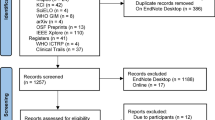Abstract
Osteoarthritis of the temporomandibular joint (TMJ OA) is the most common disorder of the TMJ. A clinical decision support (CDS) system designed to detect TMJ OA could function as a useful screening tool as part of regular check-ups to detect early onset. This study implements a CDS concept model based on Random Forest and dubbed RF\(^+\) to predict TMJ OA with the hypothesis that a model which leverages high-resolution radiological and biomarker data in training only can improve predictions compared with a baseline model which does not use privileged information. We found that the RF\(^+\) model can outperform the baseline model even when privileged features are not of gold standard quality. Additionally, we introduce a novel method for post-hoc feature analysis, finding shortRunHighGreyLevelEmphasis of the lateral condyles and joint distance to be the most important features from the privileged modalities for predicting TMJ OA.
Access this chapter
Tax calculation will be finalised at checkout
Purchases are for personal use only
Similar content being viewed by others
References
Ackermann, K., Baker, J., Green, M., et al.: Computerized clinical decision support systems for the early detection of sepsis among adult inpatients: scoping review. J. Med. Internet Res. 24(2), e31083 (2022). https://doi.org/10.2196/31083
Bianchi, J., Gonçalves, J.R., de Oliveira Ruellas, A.C., et al.: Software comparison to analyze bone radiomics from high resolution CBCT scans of mandibular condyles. Dentomaxillofacial Radiol. 48(6), 20190049 (2019). https://doi.org/10.1259/dmfr.20190049
Bianchi, J., de Oliveira Ruellas, A.C., Gonçalves, J.R., et al.: Osteoarthritis of the temporomandibular joint can be diagnosed earlier using biomarkers and machine learning. Sci. Rep. 10(1) (2020). https://doi.org/10.1038/s41598-020-64942-0
Cevidanes, L., Walker, D., Schilling, J., et al.: 3d osteoarthritic changes in TMJ condylar morphology correlates with specific systemic and local biomarkers of disease. Osteoarthritis Cartilage 22(10), 1657–1667 (2014). https://doi.org/10.1016/j.joca.2014.06.014
Chauhan, G., Liao, R., Wells, W., et al.: Joint modeling of chest radiographs and radiology reports for pulmonary EDEMA assessment (2020). https://doi.org/10.48550/ARXIV.2008.09884, https://arxiv.org/abs/2008.09884
Hu, M., et al.: Knowledge distillation from multi-modal to mono-modal segmentation networks. In: Martel, A.L., et al. (eds.) MICCAI 2020. LNCS, vol. 12261, pp. 772–781. Springer, Cham (2020). https://doi.org/10.1007/978-3-030-59710-8_75
Moradi, M., Syeda-Mahmood, T., Hor, S.: Tree-based transforms for privileged learning. In: Wang, L., Adeli, E., Wang, Q., Shi, Y., Suk, H.-I. (eds.) MLMI 2016. LNCS, vol. 10019, pp. 188–195. Springer, Cham (2016). https://doi.org/10.1007/978-3-319-47157-0_23
Rando, C., Waldron, T.: TMJ osteoarthritis: a new approach to diagnosis. Am. J. Phys. Anthropol. 148(1), 45–53 (2012). https://doi.org/10.1002/ajpa.22039
Rao, A., Palma, J.: Clinical decision support in the neonatal ICU. Seminars Fetal Neonatal Med. 101332 (2022). https://doi.org/10.1016/j.siny.2022.101332
Sabeti, E., Drews, J., Reamaroon, N., et al.: Learning using partially available privileged information and label uncertainty: application in detection of acute respiratory distress syndrome. IEEE J. Biomed. Health Inform. 25(3), 784–796 (2021). https://doi.org/10.1109/jbhi.2020.3008601
Schiffman, E., Ohrbach, R., Truelove, E., et al.: Diagnostic criteria for temporomandibular disorders (DC/TMD) for clinical and research applications: recommendations of the international RDC/TMD consortium network and orofacial pain special interest group. J. Oral Facial Pain Headache 28(1), 6–27 (2014). https://doi.org/10.11607/jop.1151
Scrivani, S.J., Keith, D.A., Kaban, L.B.: Temporomandibular disorders. New Engl. J. Med. 359(25), 2693–2705 (2008). https://doi.org/10.1056/nejmra0802472
Tanaka, E., Detamore, M., Mercuri, L.: Degenerative disorders of the temporomandibular joint: etiology, diagnosis, and treatment. J. Dental Res. 87(4), 296–307 (2008). https://doi.org/10.1177/154405910808700406
Tuppad, A., Patil, S.D.: Machine learning for diabetes clinical decision support: a review. Adv. Comput. Intell. 2(2), 1–24 (2022). https://doi.org/10.1007/s43674-022-00034-y
Vapnik, V., Vashist, A.: A new learning paradigm: learning using privileged information. Neural Netw. 22(5–6), 544–557 (2009). https://doi.org/10.1016/j.neunet.2009.06.042
Vos, T., Abajobir, A.A., Abate, K.H., et al.: Global, regional, and national incidence, prevalence, and years lived with disability for 328 diseases and injuries for 195 countries, 1990–2016: a systematic analysis for the global burden of disease study 2016. Lancet 390(10100), 1211–1259 (2017). https://doi.org/10.1016/s0140-6736(17)32154-2
Zhang, W., Bianchi, J., Turkestani, N.A., et al.: Temporomandibular joint osteoarthritis diagnosis using privileged learning of protein markers. In: 2021 43rd Annual International Conference of the IEEE Engineering in Medicine & Biology Society (EMBC). IEEE (2021). https://doi.org/10.1109/embc46164.2021.9629990
Acknowledgements
E.W. and A.R. are supported by NIH Grant R37-CA214955. E.W. was supported by T32GM070449 as well. This study was supported by NIDCR R01DE024450 and AAOF Graber Family Teaching and Research Award and by Research Enhancement Award Activity 141 from the University of the Pacific, School of Dentistry.
Author information
Authors and Affiliations
Corresponding authors
Editor information
Editors and Affiliations
1 Electronic supplementary material
Below is the link to the electronic supplementary material.
Rights and permissions
Copyright information
© 2022 The Author(s), under exclusive license to Springer Nature Switzerland AG
About this paper
Cite this paper
Warner, E., Al-Turkestani, N., Bianchi, J., Gurgel, M.L., Cevidanes, L., Rao, A. (2022). Predicting Osteoarthritis of the Temporomandibular Joint Using Random Forest with Privileged Information. In: Baxter, J.S.H., et al. Ethical and Philosophical Issues in Medical Imaging, Multimodal Learning and Fusion Across Scales for Clinical Decision Support, and Topological Data Analysis for Biomedical Imaging. EPIMI ML-CDS TDA4BiomedicalImaging 2022 2022 2022. Lecture Notes in Computer Science, vol 13755. Springer, Cham. https://doi.org/10.1007/978-3-031-23223-7_7
Download citation
DOI: https://doi.org/10.1007/978-3-031-23223-7_7
Published:
Publisher Name: Springer, Cham
Print ISBN: 978-3-031-23222-0
Online ISBN: 978-3-031-23223-7
eBook Packages: Computer ScienceComputer Science (R0)




